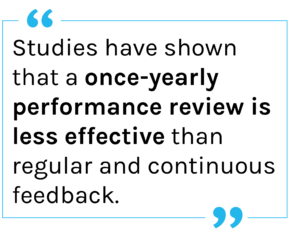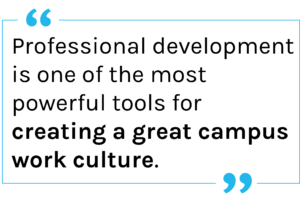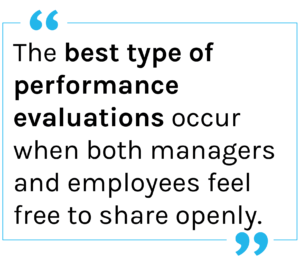Performance management in HigherEd can be complex.

Different roles in higher education can have vastly different responsibilities, and goals and success metrics can vary widely by department or college. So what are the performance management best practices for HigherEd this year?
What is performance management and why is it important?
Performance management is the umbrella term for the process of feedback, communication, and evaluation between managers and their employees. Performance management is vital for organizations so they can understand employee performance and encourage employee growth, and robust performance management processes are shown to help employees feel more engaged, often increasing retention. Having a built-in framework and a standardized, centralized digital system increases transparency, so employees, managers, and HR can all understand progress and growth. A simplified process also empowers managers and employees to complete required check-ins while easing the administrative burden for human resources teams.
Performance management best practices for HigherEd
Frequent feedback
Traditional performance management practices are shifting in many industries, as studies have shown that a once-yearly performance review is less effective than regular and continuous feedback. The benefits of more frequent feedback and reviews can be applied to HigherEd too. To prepare your employees to contribute to organizational goals and to increase retention during the great resignation. As you’re evaluating performance management processes, think about what meeting frequencies might work best for your institution—or for the different schools and departments within it. You can start with a few action steps, including: implementing employee surveys to better understand needs, facilitating discussions with department leaders, and building a simplified framework that can be used multiple times a year.
review is less effective than regular and continuous feedback. The benefits of more frequent feedback and reviews can be applied to HigherEd too. To prepare your employees to contribute to organizational goals and to increase retention during the great resignation. As you’re evaluating performance management processes, think about what meeting frequencies might work best for your institution—or for the different schools and departments within it. You can start with a few action steps, including: implementing employee surveys to better understand needs, facilitating discussions with department leaders, and building a simplified framework that can be used multiple times a year.
Goals and professional development
As a recent article from the Chronicle of Higher Education noted, colleges and universities are facing brand new challenges today and some are struggling to attract talent in a difficult market. So how can you demonstrate that your institution is a great place to work? The article notes that professional development is “one of the most powerful tools for creating a great campus work culture” and recommends having “employees create their own professional-development plans” to engage them in their own growth. Upskilling has also entered the HigherEd conversation, so be sure to consider long-term growth into new roles, rather than just professional development in the employee’s current position.
 Standardized, but flexible
Standardized, but flexible
Higher education institutions are often home to schools, colleges, or departments with varying goals and role types. With these distinct needs and requirements, there is rarely a one-size-fits-all approach for performance management. It’s important to use a platform that offers both flexibility and standardization. A standardized approach means that across your institution, guidelines are clear and consistent while reporting methods, forms, and review submissions are digital and centralized. This helps to ensure that every participant completes the process, and gives HR insight into status across campus.
A flexible approach allows each department or school to set the evaluation frameworks and goals so that their staff is measured against the metrics that truly matter and can lead to improved performance. PeopleAdmin’s Performance Management solution offers this balance between customizability and cross-campus standardization, because it was built specifically for the needs of HigherEd.
Simplify documentation
Sometimes, documentation can get in the way. Colleges and universities report that the best type of performance evaluations occur when both managers and employees feel free to share openly. Formal documents can sometimes be intimidating, making employees feel like the conversation is too official to talk openly, or can be limiting, containing the conversation to just a few questions rather than encouraging an open dialogue. Simplifying and digitizing your documentation—and making it easier to enter after a performance review—can encourage your employees to focus on productive conversations and actionable feedback, rather than just documentation or filling out forms. PeopleAdmin’s fully digital Performance Management solution supports this simplification, making it easier for managers to fulfill requirements without getting bogged down in administrative work.
both managers and employees feel free to share openly. Formal documents can sometimes be intimidating, making employees feel like the conversation is too official to talk openly, or can be limiting, containing the conversation to just a few questions rather than encouraging an open dialogue. Simplifying and digitizing your documentation—and making it easier to enter after a performance review—can encourage your employees to focus on productive conversations and actionable feedback, rather than just documentation or filling out forms. PeopleAdmin’s fully digital Performance Management solution supports this simplification, making it easier for managers to fulfill requirements without getting bogged down in administrative work.
Final thoughts
Performance management is a vital part of a positive work environment. A successful performance management process keeps managers informed, improves retention, encourages employee growth, and grows your internal talent pipeline. This year, be sure to examine your institution’s performance management to implement best practices across campus.